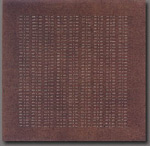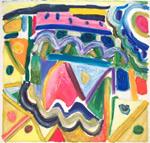Absent Reviews: Seen 'em already
| |

| My friend Bob recently forwarded me an article asking the reader when s/he had last cried at a piece of art. It was a good piece, but I can't say I'm prone to bursting into tears in front of paintings; which doesn't mean to say I'm not moved by the work. But the idea of tears seems slightly off-the-mark as a response, harping back to ideas of Romanticism and, I suspect, ideas of content over how the art is made or what it actually looks like. True, the article doesn't rail against abstraction, but I can't help feeling that it's lurking in the background. Which is strange, because the paintings I've been most moved by are probably works by Agnes Martin and Ad Reinhardt, dedicated minimalist painters both! Apart from the exhibitions I visit, it also occurred to me - and plenty of others got there first, I know - that most of the art I "see" is in reproduction. Sometimes this is because the work simply isn't around, sometimes it's because I can't get to an exhibition, sometimes it's wrapped up as a monograph, a book about the artist as much as the art they have made. And it seems to me unlikely that I'm going to cry at a painting sitting in miniature on the page. There's a batch of exhibitions on in London I haven't yet got to see but that I'd like to. But in a way I've already 'seen' them. There's a full page advert for Kenneth Noland's exhibition in the current Modern Painters magazine, and a newspaper review two weeks ago had six of his circle paintings reproduced alongside the review. I cut out the pictures and they're stuck on my studio wall at the moment, glowing circles of colour. But James, who shares the studio, says he's seen the show and they're a bit slick and airbrushed - my expectations have already fallen; I may not even bother. Maybe the idea of coloured circles is more interesting than spraygun reality? I used to be a fan of John Hoyland - his Royal Academy retrospective was ace, but I've always had a problem with the plasticity of his thick paint. That horrible acrylic just sits there, shiny and molten on the canvas. His colours shimmer and glow, but I prefer them in reproduction, flattened out by the photographic process. I ordered a catalogue of his new exhibition, and wished I hadn't. There's a stripy painting I like, but otherwise the daubs and gestural calligraphy [drawn from the tube by the look of it] seems to lack any concentration of focus. And he's started hinting at the figure, in a kind of clumsy, vague silhouette way. You can tell from the photos, too, how lumpy the paint is, its sitting there sausagelike, fresh from the tube, shiny and unworked. Ugh. It's become to easy for Hoyland, I think. Throw some wet colour around and daub some circles, lines and shapes on top. It's just not there any more for me - I keep going back to his 70s and 80s work to check that there really was something happening. |

| I didn't even know about the Doug Aitken show at the Serpentine, but my mum brought me a catalogue down last week. She and some friends had been at the V & A and then gone for a walk in the park and mum had dragged them in to the gallery [this makes a change from me dragging mum in...]. New Ocean is a set of film/video installations; both the catalogue and mum's experience suggest the piece in the basement there, of ice and ocean, is the most memorable work in the show, if not the actual focus of the exhibition. Surrounded by vast images, one is sucked into the experience, whereas later films one is more a spectator in the normal way. It's certainly my favourite exhibition I haven't seen at the moment. Gillian Ayres has a recent Lund Humphires hardback monograph out about her, written by Mel Gooding, which is sitting here on the desk, and obviously isn't a pretend exhibition, it's meant to be read as a book, meant to showcase the life as well as the work of Ayres. So I feel less guilty writing about these reproductions! [Although it occurs to me I as I re-read this that catalogues are deliberately assembled as documentation just as much as souvenir of an exhibition.] One thing that surprised me straightaway, looking through the 190 pages is how when I started looking at contemporary art at the end of the 70s I was actually 'up to date' with Ayres' work. I usually assume that a lot of the work I see at any time is 'historical' in some sense, and that I'm catching up. But, no, the claggy textures of, say, Achnabreck were fresh out of the studio, give or take a year or two - so I have actually been up to speed [whether in the flesh or reproduction] with Ayres' output. Actually, it was my partner, Sue, who was really into Ayres at the time. She had a real thing at the time for heavily painted art - Auerbach, Kossoff, Ayres, all painters who layered and layered the paint up. Ayres gradually making some kind of rhythmic and patterned sense from it, even as - to my eye - the paint got more and more tired, the colour less luminous and more grey. Only in the last decade it seems to me has the colour stayed fresh, the artist presumably working out the composition and layering more in the head than on the canvas; certainly the tiredness has gone, replaced by a vivid immediacy and apparent spontaneity. I remember to this day going up from a disappointing Braque show at the Royal Academy - all browns and blacks - to an exhibition of new Ayres' paintings and revelling in the sheer exuberance and energy of the work there. I didn't cry, but I certainly felt like shouting and leaping around. |

| Lots of my painter friends though, can't stand this kind of painting. They can only see it as decoration, and claim there's no rigour or thinking behind it; can only see it as intuition and colour. I've always disagreed, but I have to say this monograph doesn't make a strong case for intention and progression... Each chapter sees Ayres off somewhere else, be it a kind of op/pop art in the 60s, a pseudo-Monet colour field at the start of the 70s, or an accumulation of worn-out colour in the mid-70s. It's clear Ayres was much more influenced by what was going on at the time than her later work might suggest; there's little suggestion of a strong, independent character at work. The earliest paintings reproduced here from the 50s are sub St Ives school, carefully sanded and layered landscapes, tightly textured and drawn. I rather like them. Then the work loosens up and heads for splash-and-grab diptychs. The chapter concerning them is entitled 'Seeing What Paint Could Do' and the trouble is that sums it up entirely - one wonders why these kind of explorations were sent out into the world, let alone commissioned for a mural. They look like art school experiments, and none of Gooding's contextualisation and erudite comparisons can make them anything else. Then it's on to work influenced by the Abstract Expressionists, to these eyes Frankenthaler particularly. The paintings are each a self-set compositional problem resolved by discrete painted circles and squares, drawn lines and scribbled marks made over the top of a curious mix of thrown and stained paint. Patrick Heron's work springs to mind; Gottlieb's imaginary landscapes, too; and definitely Olitski. They're very beautiful, if rather typical, early 1960s paintings, which Ayres soon abandoned to make what Goodings calls 'A Digression'. Even here, he refuses to criticise, though what anyone can see in these dreadful flat painted patterns is beyond me. Eventually one supposes the penny dropped and led the painter to start painting again - for then it's into heavily-layered canvasses heading towards monochrome, but broken up with small colour interruptions. Then on through Monet and Sam Francis spots and blurs, more almost-monochromes until 'bang - hey presto!', we're where I came in: heavily painted all-over pattern abstracts which, at their best, are full of energy and light, at their worst are muddy and lifeless. [This is in stark contrast to the beautiful fresh drawings included in the book at this point, which show what might have been if the paint hadn't been so overworked.] If anything, as you can see, this book has put me off Gillian Ayres' work. It's made me think that my friends were right all along, that the artist hasn't known where she was going at all, she's been all over the place and has tried everything and anything. And however hard Gooding tries to contextualise, free-associate and discuss where the artist was living or what she was feeling at the time, it doesn't help [though this isn't to say his writing isn't informative and well written; it is - but in the end this book, or this review anyway, is about Gillian Ayres, not Mel Gooding]. There is little artistic rigour on display, and it might have been better to admit that only in the last ten or 15 years has there been a consistent body of work to show. Perhaps in ten more years a book focussing on Gillian Ayres' mature work will be made: this might be the book that convinces my friends and I that here is a serious painter at work. As it is, I shan't be shedding any tears for the moment. © Rupert Loydell 2001 |